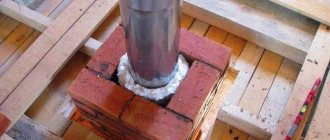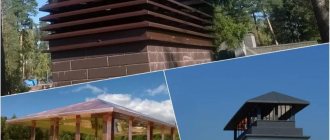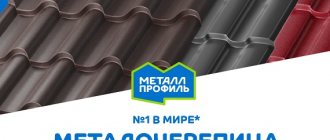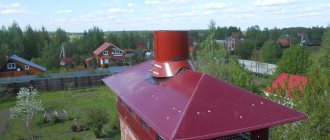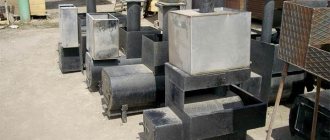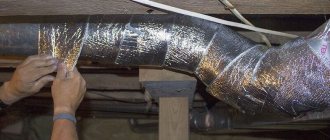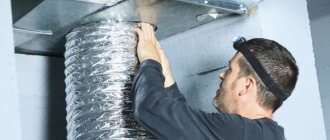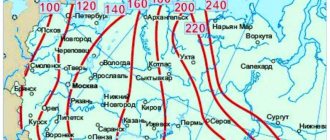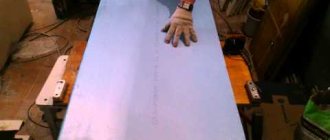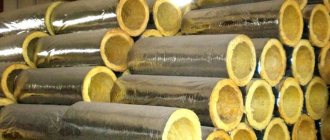Good day, dear reader! All prudent homeowners take timely care of the insulation of window and door fillings, balconies and walls of their homes. This allows them to reduce heat loss and save heating costs. But it is equally important to take care of the thermal insulation of the smoke exhaust duct in order to prevent its rapid destruction and reduce the fuel consumption of the heating device. Let's take a closer look at how to insulate a chimney pipe with your own hands.
Brief overview of the main materials for thermal insulation of a gas chimney
To insulate the chimney, materials with a low thermal conductivity coefficient and high temperature resistance are used.
The second requirement is not met by most modern insulating materials, which include polystyrene foam, penoplex, foam rubber, cellulose porous insulation and materials based on polyethylene foam. The effectiveness of a heat insulator depends on the material from which it is made and its thickness; an important characteristic is the ability to absorb moisture
Rice. 9 Popular thermal insulators (glass and basalt wool)
Glass wool
It is a material made from thin glass fibers, has high heat resistance and low thermal conductivity, is not afraid of moisture and does not absorb water. The service life of glass wool is quite high, but the material has a low density - this makes it difficult to install. Although glass wool is mainly produced in rolls, for thermal insulation it is more convenient to use foiled hollow cylinders with a slot.
Rice. 10 Thermal conductivity of insulators
Mineral wool
Basalt insulation is widely used in the construction industry due to its high insulating qualities and environmental friendliness. Mineral wool is resistant to high temperatures, but can absorb moisture; for insulation it is better to use mineral wool in the form of hollow cylinders. Mineral insulation has a high density, so it is convenient to install and process - the material is the main type of insulation for pipe chimneys.
Chimney brick. The industry produces special types of hollow bricks with a hole for the chimney pipeline; the insulation is air cavities in its walls. Chimney brick is best used together with insulation, which prevents the pipeline from contacting the brick walls. In addition to its insulating qualities, brick provides a highly decorative appearance to a residential building, hiding unsightly chimney pipes in aesthetic stone columns.
Insulation
The modern market of materials intended for construction and repair is distinguished by a wealth of choice, which fully applies to insulation materials. Among the variety of options, the following are noted:
- mineral wool;
- glass wool;
- slabs based on slag concrete;
- fiber thermal insulation;
- broken bricks, etc.
A wide range allows you to choose the optimal material suitable for use in given conditions. The following tips will help you decide on the right option:
- Buy material that is available for easy installation, as it is expected that you will have to install it yourself.
- Avoid purchasing flammable materials if you decide to insulate the chimney, since this structure, together with the part of the roof through which it passes, is constantly exposed to high temperatures.
- You should not immediately start installing the material after purchasing the material without familiarizing yourself with the method of carrying out such work. Typically, packages with insulation have attached instructions, which explain quite clearly what needs to be done and how.
How to insulate an iron chimney pipe
To insulate a metal pipe outdoors, use basalt insulation and metal clamps - the rolled insulation must be wrapped around the pipe and secured with clamps after 30-40 cm. A tool that is useful for insulation:
- Hammer, pliers, screwdriver, clamp, and other plumbing tools;
- Tape measure, metal ruler or square, building level, pencil or marker;
- A cutter or scissors to cut the insulation for chimney pipes to size;
- A device for riveting and rivets that connect the casing. Instead of rivets, short press washers can be used;
- Screwdriver or electric drill, drills Ø 3-4 mm for rivets;
- If the chimney is being plastered, you will need: a spatula and a bucket for mortar;
- To seal cracks and joints - a construction gun and bitumen mastic.
Brands of basalt insulation for chimney insulation
Various manufacturers offer consumers more than several dozen types of basalt insulation materials. Some are manufactured abroad, others at domestic enterprises.
Judging by customer reviews, the products of the following companies are popular:
- Rockwool basalt wool is manufactured at the enterprises of the company of the same name, located in Denmark. In terms of its characteristics: hydrophobicity, sound and heat insulation, as well as mechanical strength, Rockwool is significantly ahead of analogues from other manufacturers. Rockwool basalt wool is used by manufacturing companies to insulate finished ceramic chimneys from Schiedel, Effe2 and others.
Base for chimney insulation
As smoke passes through the chimney, the warm flue gases inevitably cool. As a result, the heat from the flue gases heats the walls of the tube to remove the smoke into the atmosphere.
The draft in your stove is directly proportional to how quickly the chimney walls warm up. When the draft decreases, the smoke begins to follow the path of least resistance, and simply begins to move from the stove to the scrap, and this is fraught with carbon monoxide poisoning, especially if in a private house, the stove is located directly in a private house, and not in a boiler room designated for this.
Another important factor in favor of insulating the chimney and pipe. There is such a thing as the time during which the moment of condensation appears is overcome.
The time spent warming up the chimney duct largely depends on what it is made of.
Table for calculating the temperature regime of the chimney structure
A chimney made of brick can warm up in 15-30 minutes
Photo of a brick chimney
A chimney made of steel warms up much faster - in 2-5 minutes;
Steel chimney duct
Since a hot stove chimney is constantly in contact with cold atmospheric air, the appearance of condensation in the chimney duct cannot be avoided. Along with the appearance of condensation, due to the mixing of water with carbon dioxide and other combustion products, an acidic solution is formed, which, being absorbed into the walls of the chimney duct, gradually destroys it.
If the chimney is made of brick, then the condensate moisture is absorbed into the brick walls, and this most often leads to freezing of the brickwork of the pipe. A pipe that has cooled down overnight in the cold warms up again in the morning, and it is precisely from such frequent temperature changes that the brickwork of the chimney inevitably collapses.
Brick chimney after regular freezing
So why are chimney ducts insulated? Precisely because the appearance of condensation is practically unavoidable, but we can protect the chimney from freezing and destruction, it is imperative to insulate any chimney; the sooner you do this, the longer it will be used.
Basic requirements for chimney systems for gas boilers
When installing chimney ducts, to ensure their efficient operation and fire safety, the requirements specified in the regulatory documentation SNiP 2.04.05-91 and DBN V.2.5-20-2001 must be strictly followed. Their main provisions are the following points:
- The chimney cross-section (pipe diameter) should not be less than the boiler outlet pipe.
- The main pipe should be positioned vertically without inclined sections (let's say a slope of no more than 30 degrees), and there should be no curvatures or narrowed sections in its design.
- The maximum number of turns in the branch main is no more than three with the length of side branches up to 1 meter.
- The permissible distance between the walls of the chimney and non-combustible surfaces is at least 5 cm; if it passes through combustible walls and the roof, the permissible distance is more than 25 cm.
- The material used to make the chimney duct must be resistant to high temperatures and have a structure that prevents the passage of gases.
- All connections must be sealed, the insulation must not allow moisture and gases to pass through.
- Where the pipe duct passes through the roof, the structure must be solid and without joints.
Rice. 3 Boiler piping diagram
- At the bottom of the pipe there is usually an element for collecting condensate. The material used to make it must be resistant to moisture and gas combustion products.
- In places where turns are provided, inspection hatches must be located to clean the chimney from contaminants and condensate.
- The length of the chimney duct must provide good draft, the height of its outer part must be at least 50 cm above the roof ridge.
- When installing a smoke exhaust channel, it is necessary to have a protective canopy in its upper part to prevent the ingress of dirt and precipitation.
Expert advice
Install a smoke exhaust channel according to the rules. It is also worth taking advice from experts. Thermal insulation is carried out according to the following standards:
- thermal insulation must be applied in a continuous layer, without transitions, especially in places of contact with the ceiling and roof;
- mats and strips are laid only with the markings facing outwards;
- installation of parts is carried out from the bottom up, overlapping, the lower end is covered with the upper connection;
- internal insulation is carried out in stages, during installation of the structure, external insulation after complete assembly;
- a spark arrester is installed at the end if the roof consists of flammable materials;
- use personal protective equipment.
The rules are simple; following them will help prolong the operation of the output channel.
How to insulate a chimney pipe
You can make a chimney insulated using different materials. Their cost is not of serious importance, since little insulation itself is required
But the owner must pay special attention to the insulation technology itself. Usually the chimney pipe is insulated from the outside
To ensure decent insulation, it is better to focus on fiber insulation. These include mineral and glass wool. Thermal insulation can be increased using slag concrete, broken bricks and similar materials. The most important thing is that the insulation used has high fire safety, because the heating temperature of the pipe can be very high.
It is better for the home owner to choose thermal insulation materials that he can install on his own. Before performing any procedures, you should read the manufacturer's instructions
Particular attention should be paid when working with glass wool, as it emits dangerous crumbs. You cannot do without protective equipment while working with it.
The technology of pipe insulation is also determined by the material from which this element is made. Most often, brick, steel and asbestos cement are used to create a chimney. Each of these cases has its own characteristics of thermal insulation work.
How and with what to insulate an asbestos chimney pipe
A chimney made of asbestos cement must be insulated with mineral wool. Before the main work, any dust and debris present should be removed from this element. The insulation will be placed in a special casing, which is made of galvanized iron. The diameter of the casing is selected so that it is 6 cm larger than the diameter of the chimney pipe.
The length of this insulation design can be different. But it is made up of parts inserted into each other. Each element has a maximum length of 1.5 meters. When the casing is put on, insulation is laid between it and the pipe. After compacting it tightly, you can put on the next element, thus extending the pipe.
The remaining voids are filled with cement mortar. The last element of the casing should be inclined. Sometimes owners manage to do without a metal casing. If this option is chosen, then the mineral wool needs to be wrapped with clamps. But it is better to use several slabs of mineral wool.
To increase the service life of such a thermal insulation structure, it is necessary to additionally carry out vapor and waterproofing. Otherwise, the mineral wool will deteriorate.
How and with what to insulate a steel chimney pipe
Today it is not difficult to find a steel chimney in a hardware store that has an additional thermal insulation layer. This design is made using two pipes having different diameters. In the space between these elements there is a fire-resistant thermal insulation material. But you can do this kind of insulation yourself.
To do this, two pipes are taken that differ in diameter. The smaller pipe is placed inside the larger one, and the free space is filled with fiber insulation. In this case, you don’t even need to prepare any complex tools. All you need is a tape measure, fasteners, a screwdriver, a stationery knife and a grinder for cutting the material. Scotch tape is also useful, which can be used to fasten individual pieces of insulation.
How and with what to insulate a brick chimney pipe
The most difficult thing for the owner is if he is faced with the task of thermal insulation of a brick pipe. There are two possible options here, each of which is worth dwelling on in detail.
1. Insulation with plaster
The outer side of the brick chimney is covered with reinforced mesh. A plaster solution is applied to it so that its thickness is about 3 cm. You need to prepare the plaster from slag and lime, adding a little cement. Usually 2 layers are applied, the first of which is liquid. When it dries, you can cover the work surface with a thick solution. Having leveled the plaster, you need to rub it well. The chimney is then coated with lime to improve its appearance.
2. Insulation with asbestos cement and mineral wool
A brick chimney is first covered with mineral wool, after which an asbestos-cement lining is formed. In this case, asbestos-cement boards are used. They can later be plastered.
How to properly insulate a chimney pipe
The best decision for the home owner would be to insulate the chimney immediately after the construction of the building is completed. If you miss this moment, the chimney pipe may no longer be saved, as it will begin to collapse. As a result, there will be a need to replace or repair the chimney completely.
Preparatory work before installing thermal insulation
Before carrying out thermal insulation work, you should check the reliability and strength of the foundation that was built under the stove or other heating equipment.
If there is no foundation, then before insulating the chimney, you will need to assemble a supporting structure under the outer casing. This can be either a support bracket, which can be purchased in a store, or a welded frame made from angle steel. Typically, for steel chimneys, ready-made support brackets are used, and in the case of a brick chimney, the foundation design is already designed for current loads.
After this, you should carefully inspect the place where the chimney exits through the ceilings and roof. The outlet through the ceiling must be protected by a steel box. The minimum distance from the chimney to the walls of the duct is at least 20 cm. When exiting through the roof, the chimney should not come into contact with the roof structures. To do this, you should provide appropriate spacers or a special cap that is mounted outside the building.
The chimney outlet through the ceiling must be protected by a metal box
Step-by-step insulation technology
Due to the fact that chimneys come in different types and designs, we will describe how to properly insulate a chimney pipe made of brick, asbestos cement and steel.
Chimneys made of asbestos cement
Asbestos cement pipe
To understand how to insulate a chimney from an asbestos pipe, we will analyze the entire procedure step by step, following the recommendations of professional builders:
First, you need to thoroughly clean the work area from dust and dirt; The next step is to make a special folding casing for the insulation (made from galvanized iron)
When determining its parameters, it should be taken into account that at least 6 cm should remain between the pipe and the iron for insulation; Pay attention to the fact that a casing assembled from several parts is put on the asbestos pipe, and each of them should not exceed 1.5 m; First of all, you should secure the lower part of the casing and carefully fill it with sealant. Then, the second part is put on and the procedure is repeated.
This design must run along the entire length of the asbestos pipe.
Thermal insulation diagram from a home craftsman
This is what an asbestos chimney with a casing looks like
Often, many cottage owners do without a casing. The pipe is simply wrapped in a roll of mineral wool and secured with staples. In order for this method of insulation to become truly reliable, several layers should be wound.
Steel chimneys
So, we seem to have sorted out the asbestos pipes, now let’s see how to insulate the metal chimney pipe. In general, many manufacturers of building materials produce ready-made chimneys made of stainless steel. The design is quite simple and consists of only two pipes of different diameters.
How to insulate a metal chimney? To do this, take a pipe of smaller diameter and insert it into a pipe of larger diameter. Then, the remaining space between the pipes is filled with any of the above types of insulation. If you are interested in modern materials, then we can recommend basalt chimney insulation, which in its structure resembles mineral wool, but is much more practical and durable.
Thermal insulation of a steel chimney
In principle, it is much easier to insulate an iron pipe than an asbestos pipe, so there should be no problems here.
Brick chimney
Brick chimney
Insulating a brick chimney is perhaps the most complex type of all presented in this article. Now we will present several options, from which everyone will choose for themselves how to insulate a brick chimney:
Plastering method. To do this, you will need to attach a reinforced mesh to the chimney. Then prepare a solution of lime, slag and a small portion of cement. Spread the resulting solution over the entire surface of the chimney and level it (all work is done in one layer, which should be at least 3 cm).
When the solution dries, you can add a few more layers and immediately cover up the resulting cracks. To give an attractive appearance, the pipe can be whitewashed or painted in the future.
Thermal insulation diagram of a brick chimney
Insulation with mineral wool. To do this, you will need to take a roll of basalt wool and cut it into pieces that correspond to the dimensions of the chimney area. Then, the insulation is glued to the pipe using tape. The last step of the work is to lay insulation (for example, Rocklight) with a second layer of bricks or asbestos-cement slabs.
The process of thermal insulation of a chimney with mineral wool
Good luck!
Conclusions and useful video on the topic
Insulation of a steel gas chimney:
To ensure high-quality removal of gases generated as a result of combustion, insulation of the chimney pipe is a vital necessity. Mineral wool is considered the ideal insulation material; it is this material that meets all the requirements for high-quality and reliable insulation.
Purchasing ready-made insulated modules will help speed up installation work. But you can carry out insulation yourself with basalt wool, and get an analogue of a sandwich pipe at a lower cost. The use of cylinders and shells made of mineral wool can significantly speed up the process of chimney insulation.
Would you like to share your own experience in thermal insulation of a gas boiler pipe? Do you have useful information that will be useful to site visitors? Please write comments in the block form below, ask questions, post photos on the topic of the article.
Why insulate chimney pipes
To eliminate conditions for the formation of condensation on the walls of the chimney pipe. This is due to the fact that flue gases, coming into contact with the cold walls of the pipe, deposit a wet film on it, which, interacting with soot (unburnt waste), forms harmful chemical compounds that destroy the walls and have an unpleasant odor.
The phenomenon of condensation in nature manifests itself when the moisture content in the air is oversaturated as a result of its cooling, it contracts, increases in density and, having reached the “dew point”, the moisture falls in the form of precipitation (small droplets, fog).
Smoke vapor also has a “dew point”; this point can be located and change its position along the entire length of the pipe. So, for example, when the stove is ignited, it can be located directly in the firebox and, as the pipe channel warms up, it can rise higher and higher until it “flies into the chimney.”
By the way, this expression tells us that the stove must be heated correctly so as not to waste extra firewood: the best option is that the temperature at the beginning of the pipe channel should be in the range of 250-300°C, and at the outlet from 100°C to 150°C WITH.
It is necessary to strive to reduce the time for condensation formation, and this can be achieved by quickly heating the inner surface of the pipe. This is why it is necessary to insulate chimneys. In houses with year-round occupancy, this must be done in order to minimize the amount of condensate formed, since its chemical composition contains dissolved harmful substances, including sulfuric acid, which destroys the pipe channel.
Materials and methods of insulating chimneys.
If the chimney runs from the outside of the building, then it must be insulated along its entire length. Brick pipes can be insulated by plastering using fiberglass mesh and basalt wool insulation. This method has become widespread during the overhaul of Khrushchev-era apartment buildings and is called a thermal fur coat. Materials for thermal fur coats can be purchased at any construction market. The fur coat includes:
- fasteners (dowel and nail with a pressure washer);
- plaster mesh (strong glass fabric, woven in a special way - most known as SSSH - 160)
- insulation (slabs, mats made of mineral wool or expanded polystyrene)
- polymermineral glue (SARMALEP)
- plaster (special finishing composition – SARMALIT)
- paint (special paint for plaster – SOFRAMAL)
The insulation technology is simple: using dowels and nails, the mats are attached to the outer wall of the pipe, the surface of the mat is glued and a mesh is applied, then a layer of plaster and paint are applied to it. This design is very light and does not require additional reinforcement of the walls or emphasis on the foundation.
It happens that you need to install a pipe to additional equipment installed in the utility room or basement. Here you can use a prefabricated system of pipes in the form of a sandwich, which do not require insulation and allow installation through the wall. This is a prefabricated system consisting of heat-resistant stainless pipes (pipe in pipe), the interpipe space of which is filled with non-flammable material with very low thermal conductivity. You can select pipes of the optimal cross-section for your heating system by studying the installation and operating instructions.
Do I need to insulate the outside?
As warm exhaust gases pass through the pipe, they are cooled. When cooling, condensation forms on the walls, which can lead to destruction of the chimney pipe.
Also, the draft force in the furnace or boiler depends on how quickly the pipe walls heat up. If the draft is weak, then carbon monoxide will not rise to the top, but will go down, that is, into the house, and this already threatens poisoning.
Any chimney needs to be insulated, whether it is a stove or a boiler, and regardless of what it is made of (brick, metal, asbestos). Carbon dioxide mixes with condensate to form a weak solution of sulfuric acid. Acid destroys metal chimneys, even though chimneys with oxidation protection are available.
Brick pipes are destroyed when condensate gets into cracks, which expand when moisture freezes in them, which can lead not only to the destruction of the pipe, but also the roof itself. The conclusion suggests itself - it is imperative to insulate.
Video: Chimney insulation
This way we protect it from freezing and destruction. So, the sooner we do this, the longer it will serve us.
How to insulate
For insulation you can use materials such as:
- glass wool;
- fiber insulation;
- broken refractory or red brick;
- plaster.
Plastering is not the best way to insulate. A metal mesh is fixed to the pipe and several layers of slag and lime solution are applied. With this option, you will have to grease up the fallen plaster every year. Therefore, you should think twice about the effort-quality ratio before choosing this method of insulation.
Backfill – thermal insulating bulk materials of different sizes are used. One of the simplest and cheapest options. You can use rubble refractory or red brick, expanded clay, slag, etc.
Mineral (stone) wool - made from rocks of basalt origin, some add glass (glass wool). The most popular and reliable method. But there is a drawback: it requires protection from a steel casing. Without additional protection, cotton wool will not last long - wind and moisture will ruin all your efforts.
When choosing insulation, it is better to focus on the quality of the product, since you don’t need very much material. How long the chimney will last depends on the quality of the insulation and the work performed.
How to insulate a metal chimney pipe
A separate topic for thought is steel chimneys. A special type of stainless steel is used as a material for modern chimney pipes. The functionality of stainless steel is very high. Firstly, the pipe warms up quickly. Secondly, it does not rust from moisture.
The so-called sandwich chimneys have become widespread. These are structures that consist of two pipes of different diameters. Insulation is laid between them. However, such chimneys have a number of disadvantages, including their price and service life. The advantage is that sandwich chimneys are already insulated. You just need to install them correctly. The quality of chimney insulation is guaranteed by the manufacturer.
Sandwich chimneys help retain up to eighty percent of heat. This means that this type of chimney pipes can be called the most efficient.
However, you can also insulate a steel chimney yourself. To do this, glass wool is selected as insulation, which is wrapped around the pipe, then fixed with wire and foil. In addition, some craftsmen create homemade sandwich chimneys. In addition, they are insulated not only in the space between the pipes, but also outside.
When working with mineral wool you need to be very careful
It is important to ensure that particles of the material do not come into contact with the skin, eyes or respiratory organs. It is recommended to carry out all work wearing gloves
Insulating the chimney will not only preserve its durability, but will also create a beautiful appearance. It is much nicer to look at a plastered brick chimney than at ordinary brickwork. The same can be said about asbestos pipes protruding from the roof.
Insulation of chimneys of any type is done with your own hands - without the involvement of specialists. You just need to do all the work carefully. Insulation materials play an important role in chimney insulation. You need to choose a material that is not susceptible to fire. Fires often occur in the house due to chimneys.
Now that all the work has been completed, you can evaluate the work. First of all, condensation will not form in the chimney. This is not to say that it will not exist at all. However, this is much less than without insulation. In addition, little soot will form in the pipe, which over time can ignite and cause a fire.
Chimney insulation must be approached responsibly. The work requires care and precision. Otherwise, the desired effect will not be achieved. For work you need to use only high-quality and safe materials.
How to avoid common mistakes - experts recommend
Before insulation, especially of an asbestos-cement or steel chimney, make sure that the structure is installed correctly. The gas exhaust pipe must comply with fire safety rules and other technological standards.
It is recommended to use insulation that breathes and does not accumulate moisture. In other cases, ventilation gaps of at least 25 mm must be left. Use materials that are available for self-installation. Manufacturer's instructions are followed.
Among mineral insulation materials, basalt wool is the most effective. It is somewhat more expensive than the usual mineral one, but with low consumption this does not play a significant role. But in reality there are significant advantages:
- fire is possible at very high temperatures;
- has increased density;
- significant vapor permeability.
Basalt wool is good for thermal insulation both outside and in the attic.
Even the highest quality thermal insulation does not extend the life of the structure if it is not first brought to the proper condition: cleaning and replacement of damaged elements is required.
Work on external insulation of the chimney is carried out immediately after its construction. After a few years, destructive processes begin that thermal insulation can no longer stop. Repair or complete replacement of the structure will be required.
Why is chimney insulation necessary?
The main task of thermal insulation of a chimney pipe is to create thermal conditions under which condensation will not form in the pipe cavity. As is known, due to a significant temperature difference between the interior of the operated chimney and the cold outside air, condensate forms in significant quantities on the walls inside the pipe. Insulating the chimney allows you to move the so-called dew point outside the chimney, thereby eliminating the very cause of moisture condensation.
The condensate formed in the chimney contains water and a solution of sulfuric acid, which is obtained as a result of complex processes that occur during fuel combustion. The result of exposure of the pipe to such an “explosive” mixture is its active destruction from the inside.
This applies to the maximum extent to single-layer pipes made of metal. Sandwich, brick and asbestos-cement pipes are somewhat less susceptible to harmful effects.
Condensation stains caused by lack of pipe insulation
